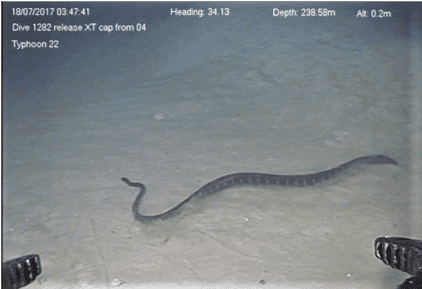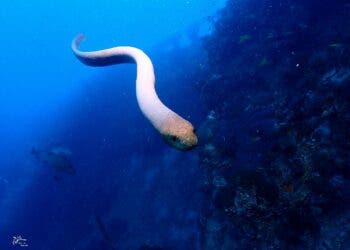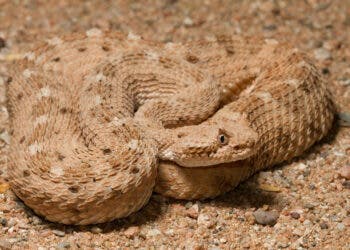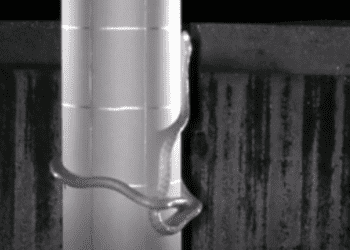Snakes — they’re slithering on the ground, climbing trees, and now they’ve taken to the deep sea. A team of Australian researchers spotted two snakes swimming at depths of 239 and 245 meters, respectively — smashing the previous record by a whopping 133 meters.

There are more than 3,000 snake species on Earth, and there’s at least one on every continent except Antarctica. They come in all sizes, ranging from a meager 10 centimeters to a whopping 10 meters (in the case of the reticulated python). They also inhabit an impressive array of habitats. Most live on the ground, but some are arboreal, and some even dwell around caves. There’s also a group of sea snakes.
Sea snakes are a highly venomous family inhabiting the warm coastal waters from the Indian Ocean to the Pacific. They dwell almost exclusively in water, and most of them are completely unable to move about on land. They’re excellent swimmers, being capable of swimming several kilometers in one go, and they also dive to search prey. However, they still need to breathe, and researchers thought they only dive to shallow depths. Until now.
“Sea snakes were thought to only dive between a maximum of 50 to 100 metres because they need to regularly swim to the sea surface to breathe air, so we were very surprised to find them so deep,” says Dr Jenna Crowe-Riddell, lead author of the study and recent PhD graduate at the University of Adelaide’s School of Biological Sciences.
The snakes were filmed in 2014 and 2017 using a remotely operated vehicle (ROV). The fact that there were two separate observations of two different species suggests this is not a freak occurrence, and sea snakes are quite capable of diving to these depths.
At depths of over 200 meters, things start to change dramatically. Very little light passes through to that depth, which is why this area, technically called the mesopelagic zone, is also referred to as the ‘marine twilight zone.’
Water pressure is also substantial at that depth, and for surface creatures to go that deep, you need very specific adaptations. The temperature is also quite low — which is quite challenging to cold-blooded creatures like snakes. This raises new questions about the thermal tolerance and overall ecologic capabilities of these snakes.
“We have known for a long time that sea snakes can cope with diving sickness known as ‘the bends’ using gas exchange through their skin,” says Dr Crowe-Riddell. “But I never suspected that this ability allows sea snakes to dive to deep-sea habitats.”
This also highlights the need to better understand these environments, which are at risk from climate change, ocean acidification, and human activity — better conservation first requires better understanding.
The study “First records of sea snakes (Elapidae: Hydrophiinae) diving to the mesopelagic zone (>200 m)” has been published in Austral Ecology. https://doi.org/10.1111/aec.12717






